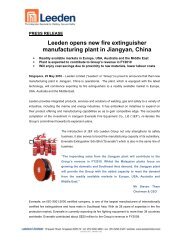Annual Report 2010 - Leeden Limited
Annual Report 2010 - Leeden Limited
Annual Report 2010 - Leeden Limited
Create successful ePaper yourself
Turn your PDF publications into a flip-book with our unique Google optimized e-Paper software.
A Stronger <strong>Leeden</strong> in Asia.Notes to the Financial Statementsfor the Financial Year ended 31 December <strong>2010</strong>2. Summary of significant accounting policies (cont’d)2.5 Transactions with non-controlling interestsNon-controlling interest represents the equity in subsidiaries not attributable, directly or indirectly, to owners of theCompany, and are presented separately in the consolidated statement of comprehensive income and within equity in theconsolidated balance sheet, separately from equity attributable to owners of the Company.Changes in the Company owners’ ownership interest in a subsidiary that do not result in a loss of control are accountedfor as equity transactions. In such circumstances, the carrying amounts of the controlling and non-controlling interests areadjusted to reflect the changes in their relative interests in the subsidiary. Any difference between the amount by which thenon-controlling interest is adjusted and the fair value of the consideration paid or received is recognised directly in equityand attributed to owners of the parent.2.6 Foreign currencyThe Group’s consolidated financial statements are presented in Singapore Dollars, which is also the parent company’sfunctional currency. Each entity in the Group determines its own functional currency and items included in the financialstatements of each entity are measured using that functional currency.(a)Transactions and balancesTransactions in foreign currencies are measured in the respective functional currencies of the Company andits subsidiary companies and are recorded on initial recognition in the functional currencies at exchange ratesapproximating those ruling at the transaction dates. Monetary assets and liabilities denominated in foreigncurrencies are translated at the rate of exchange ruling at the balance sheet date. Non-monetary items that aremeasured in terms of historical cost in a foreign currency are translated using the exchange rates as at the datesof the initial transactions. Non-monetary items measured at fair value in a foreign currency are translated using theexchange rates at the date when the fair value was determined.Exchange differences arising on the settlement of monetary items or on translating monetary items at the balancesheet date are recognised in profit or loss except for exchange differences arising on monetary items that form partof the Group’s net investment in foreign operations, which are recognised initially in other comprehensive incomeand accumulated under foreign currency translation reserve in equity. The foreign currency translation reserve isreclassified from equity to profit or loss of the Group on disposal of the foreign operation.(b)Group companiesThe assets and liabilities of foreign operations are translated into SGD at the rate of exchange ruling at the balancesheet date and their statements of comprehensive income are translated at the weighted average exchange ratesfor the year. The exchange differences arising on the translation are taken directly to other comprehensive income.On disposal of a foreign operation, the cumulative amount recognised in other comprehensive income relating tothat particular foreign operation is recognised in the profit or loss.In the case of a partial disposal without loss of control of a subsidiary that includes a foreign operation, theproportionate share of the cumulative amount of the exchange differences are re-attributed to non-controllinginterest and are not recognised in profit or loss. For partial disposals of associates or jointly controlled entities thatare foreign operations, the proportionate share of the accumulated exchange differences is reclassified to profit orloss.The Group has elected to recycle the accumulated exchange differences in the separate component of othercomprehensive income that arises from the direct method of consolidation, which is the method the Group uses tocomplete its consolidation.50





